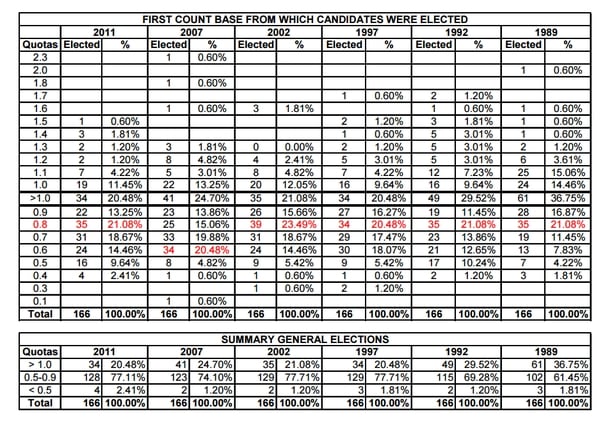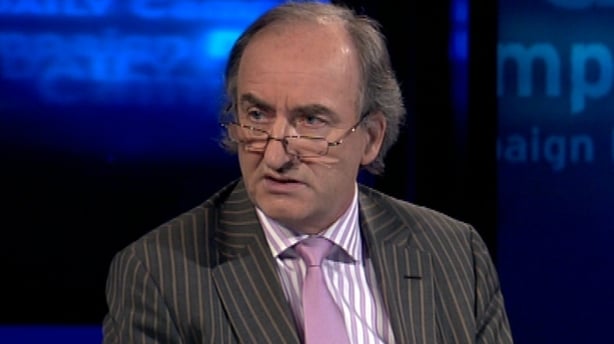Candidates have to be in the frame on the first count

For a candidate to have a good chance of getting elected they have to be in the frame on the first count. This means that, as a general rule, in a five-seat constituency the candidate has to come in the first five on the first count.
In a three-seat constituency the candidate has to be in the first three places and in the first four in a four-seat constituency.
In the 2011 general election, there were only 11 candidates who came from outside the frame to get elected. In other words, 93% of those elected were within the frame on the first count.
An example of one of those 11 occurred in the four-seat Clare constituency in 2011, where Fine Gael's Tony Mulcahy was in fourth place on the first count.
Fianna Fáil's Timmy Dooley was in fifth place but managed to overtake Mr Mulcahy and went on to take the fourth and final seat. Thus, Mr Dooley came from just outside the frame to claim a seat.
The idea of a "Lazarus" type recovery rarely happens and when this rule is broken it is usually from a position just outside the frame, as in Mr Dooley's case. Transfers are important but they do not always have the influence that we often think they do.
Candidates must have at least half a quota on the first count

A candidate must have at least half a quota on the first count to have any chance of getting elected.
Only four of those elected in 2011 got below half a quota on the first count, with only two in 2007 and three in 1997.
In other words 98% of those elected had at least half a quota on the first count. It is important to note that half a quota will not guarantee a seat but less than that level will leave a candidate with very little chance of getting elected.
These two election rules are usually broken by political parties running too many candidates.
A good example of this in 2011 was in the constituency of Donegal South-West where Fianna Fáil ran two candidates, Mary Coughlan and Brían Ó Domhnaill.
Both candidates were outside the frame on the first count and both were below the half quota level. Independent Thomas Pringle slipped through for the final seat.
Thus, Fianna Fáil, with 0.9 of a quota on the first count, were beaten by Mr Pringle, who had just 0.5 of a quota.
The Fianna Fáil Donegal South-West performance contrasted sharply with its neighbouring constituency of Donegal North-East where the party won just 17.44% of the first preference vote as against 22.53% in South-West, but won a seat by running just a single candidate.
It is not so much the number of votes you have but rather how you manage these votes.
The Donnelly Rules and Election 2011: Seats Changed By Transfers
Our voting system is based on proportional representation using the single transferable vote (PR-STV).
The general view is that the distribution of transfers substantially affects the final outcome in most constituencies. But on closer examination, this is not quite the case.
Of the 165 seats filled in the 2011 election, in only 11 cases (14 in 2007) was the first count result changed after the transfers were completed.
In other words, if the election had been declared after the first count, it would have differed by only 11 seats from the eventual result, or by just 7% of the total seats.
This figure was 8% in 2007, 11% in 2002 and 1997, 10% in both 1992 and 1987, and only 8% in 1989.
In 2011, two of these were battles between two candidates of the same party, thus the transfers only changed the overall party seats by nine – or just 5% of the total.

Of course, if we were operating a "first past the post" system, parties would run fewer candidates and the result would be different, but the point remains that the transfers do not significantly change the first count result.
Thus, the first count is extremely important and what the figures clearly indicate is that if a candidate is not "in the frame" on the first count, he or she has less than a 10% chance of eventually winning a seat.
This illustrates the advantage of running the minimum number of candidates, as once the vote is divided the chances are that the candidates will end up outside the frame on the first count.
Furthermore, as can be seen from the table of first count bases from which candidates were elected, it is obvious that, to have a reasonable chance of a seat, a candidate must attain at least half a quota on the first count, as all but four of the candidates elected in 2011 (two in 2007 and 2002 and three in 1997 and 1987) had at least that level of support.
Only two of the members elected in 1992 had less than 0.5 quotas.
Cyprian Brady really pushed the boat out in 2007 as he went on to win a seat from a first count of 939, just 0.1 of a quota or a mere 2.71% of the first preference vote.


By Pollster Sean Donnelly

Read more from this author:
Will Election 2016 signal the end of Civil War politics? |
Election 2011: Did you know?

